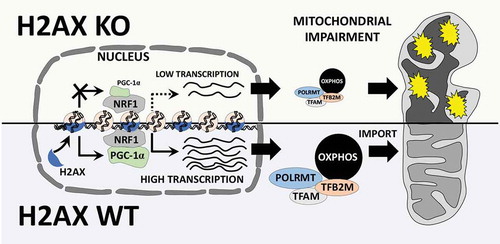Figures & data
Figure 1. Potential role for histone H2AX in mitochondrial homeostasis. H2AX is involved in fine control of mitochondrial biogenesis and respiration genes. Cells deficient for H2AX exhibit repression of the transcription co-activator PGC-1α (PPARG coactivator 1 alpha (PPARGC1A), best known as PGC-1α), and the subsequent diminution of PGC-1α transcription targets such as TFAM, TFB2 M, POLRMT, as well as reduction of oxidative phosphorylation subunits (OXPHOS). These alterations lead to deregulated import of proteins into the mitochondria, and enhanced repression of mitochondrial transcription, replication and repair processes. As a result, cells lacking histone H2AX exhibit accrued mitochondrial damages, as well as impairment of mitochondrial homeostasis.

